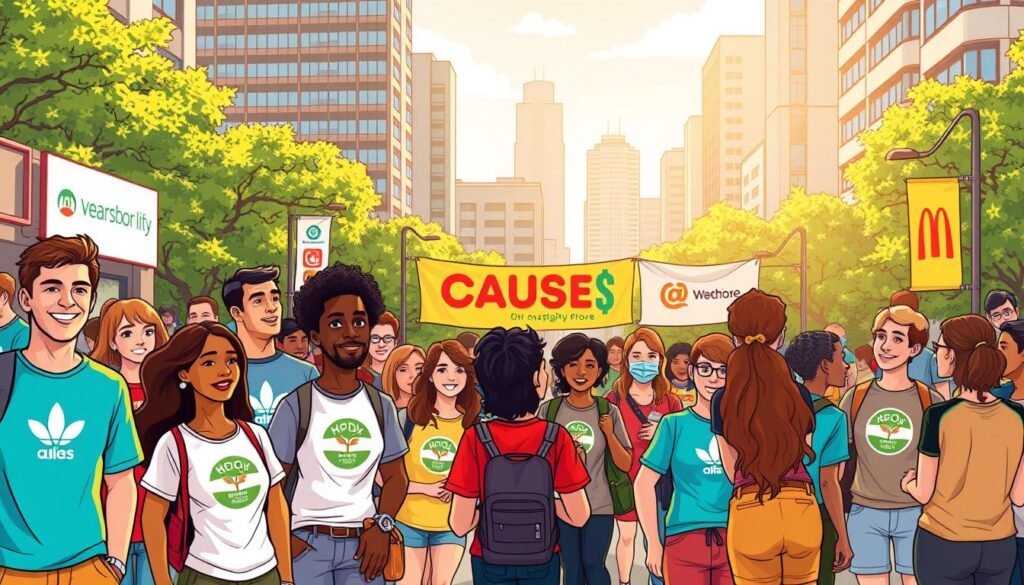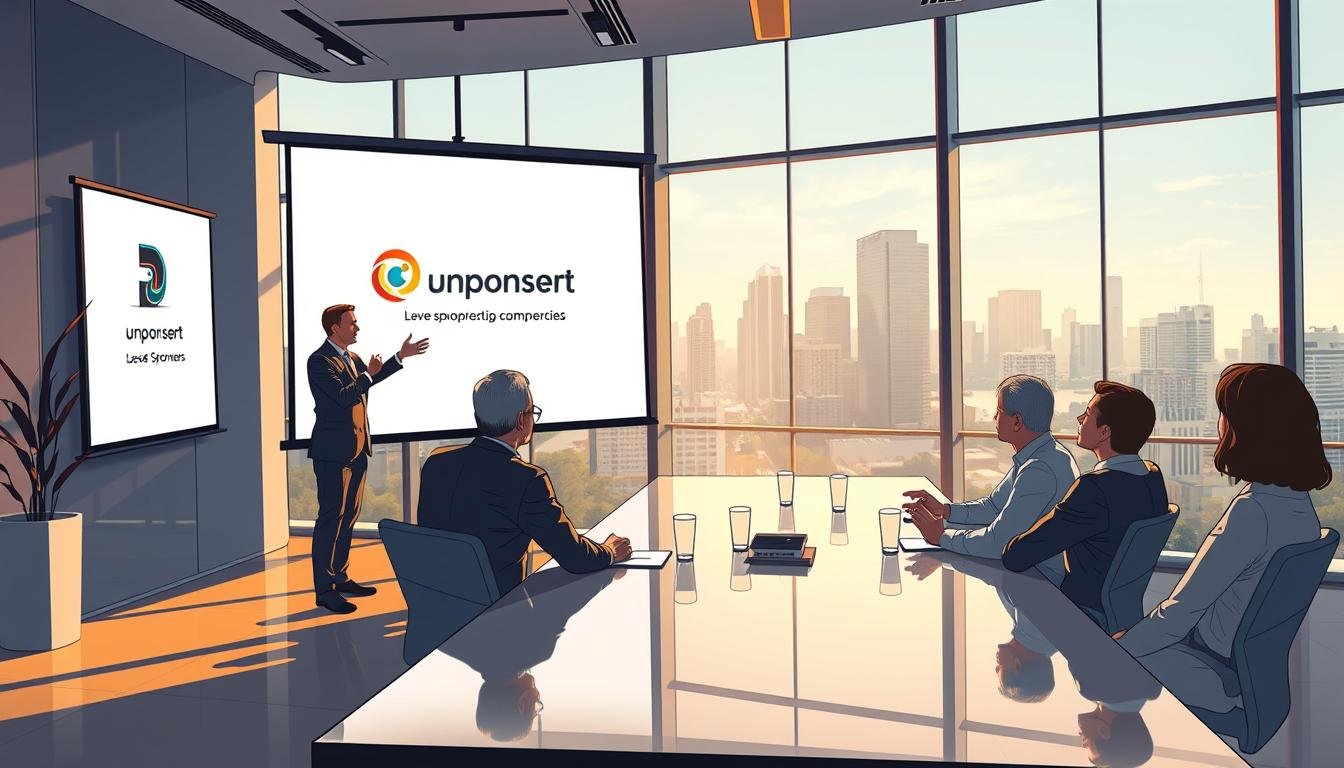Sponsorship and branding strategies
Can one sponsorship deal make a brand famous? Global spending on sponsorships reached $0.9 billion in 2023. It’s expected to hit $1.2 billion by 2027. But how do brands like BMO, Subaru, and Red Bull succeed? This guide uncovers their secrets.
Key Takeaways
- Vertical integration strategies, like BMO’s soccer team sponsorships, boost authenticity across mass and niche markets.
- Brands such as Subaru and Red Bull use event ownership to control messaging and amplify brand loyalty.
- Unified platforms like TD Bank’s TD Music program align sponsorships with core brand values for stronger recognition.
- Strategic sponsorships drive measurable results, including increased sales and customer engagement.
- Aligning with events that share your brand’s mission, like Pabst Blue Ribbon’s niche subculture focus, builds lasting connections.
Strategic sponsorships are more than just logos and banners. They’re about telling stories. A small business can boost its reputation by backing local races. A big company can dominate industry events. This guide shows how every brand can create powerful sponsorship and branding strategies.
Discover how to choose the right partnerships, measure success, and avoid mistakes. All while staying true to your brand’s identity.
Ready to make sponsorships work for your growth? Let’s start.
Understanding the Power of Strategic Brand Partnerships
Marketing partnerships and brand sponsorships help businesses grow by combining their audiences and resources. When they match brand values, these collaborations can increase reach and trust. Let’s look at how these partnerships shape how people see brands and bring measurable results.
Think of GoPro and Red Bull: their long-term partnership made extreme sports videos famous, boosting their adventurous images. Also, Nike Air Jordan and Dior teamed up, mixing streetwear with luxury, growing their markets. These stories show how brand sponsorships can change a brand’s story.
- Joint marketing partnerships cut costs by sharing ad expenses.
- Brand sponsorships like Coca-Cola’s Olympic Games tie-in build long-term global recognition.
- Events such as BizX galas offer chances for sponsors to shine through naming rights and interactive booths.
Psychology is key—people see brands linked to respected partners as more trustworthy. Tools like 6Connex track how well sponsorships work, showing they boost ROI through social media shares and event attendance. Whether it’s launching special products or sponsoring events, strategic partnerships make two brands stronger together.
The Evolution of Sponsorship and Branding Strategies in America
Sponsorship and branding have changed a lot over time. They’ve moved from just putting logos on things to creating full experiences. In the early 20th century, brands like Coca-Cola started working with big events, like the Olympics in 1928. This was the start of how we see branding today.
In the 1980s, brands started to buy naming rights for places like Wrigley Field. This showed how brands could become a part of our culture.
Now, we use technology and data to connect with people in new ways. Social media has become key, as seen with Stephen Curry’s deal with Under Armour. They used Instagram and Twitter to reach millions of fans.
Today, brands focus on making people interact with them, not just seeing ads. This includes things like in-game ads and special jersey patches in sports.
| Year | Development |
|---|---|
| 1920s | Radio ads and early sports sponsorships |
| 1950s | TV broadcasts expand brand visibility |
| 1990s | In-stadium naming rights boom (e.g., Crypto.com’s $700M Staples Center deal) |
| 2020s | Data-driven campaigns and virtual experiences |
Today, brands focus on being real and true to themselves. They use things like Bud Light’s NFL deal to tell their story. They also use data to make sure their money is well spent.
As the sports sponsorship market grows, brands need to keep up. This means using new tech and finding ways to connect with fans in small moments.
- Legacy brands like Coca-Cola maintain century-long sponsorships for trust-building
- Digital-first strategies use influencers and social media for real-time reach
- Data integration tailors campaigns to audience preferences
From old naming rights to new tech, the story of sponsorship shows one thing. To be effective, brands must always be ready to change with the times.
Assessing Your Brand’s Readiness for Sponsorship Opportunities
Before you dive into sponsorship opportunities, make sure your brand is solid. Start by clearly defining your core values and brand identity. Ask yourself: Does every potential partnership reflect your mission? Misaligned sponsorships can confuse your audience.
Next, set clear goals. These could be to boost awareness in specific markets or to rebuild trust after a setback. These goals should align with your marketing or sales plans.
- Core Values Audit: Review internal documents to ensure all strategic sponsorships align with your mission.
- SMART Goals: Define Specific, Measurable, Achievable, Relevant, and Time-bound objectives.
- Budget Breakdown: Allocate funds based on high-impact elements like branded booths or speaking slots.
Budgeting is about finding the right balance. Strategic sponsorships need resources but can pay off big: 80% of brands say live events are key for growth. Start small with pilot programs to test ROI before scaling. Use tools like QR codes or social listening to track metrics like impressions or sentiment shifts.
Regularly check if your brand is ready for sponsorships using surveys and data. Tools like sponsorship scorecards help spot any issues in alignment or budget. By making decisions based on core values and data, you ensure every partnership strengthens your brand’s voice.
Identifying the Perfect Sponsorship Match for Your Brand
Let’s get started. The user wants me to write about finding the right sponsorship for your brand. We’ll use keywords like “sponsorship opportunities” and “marketing partnerships”.
First, we’ll follow the outline. We have an H2 heading and will add H3 sections later. The intro will be brief, focusing on finding the right partners.
We’ll use examples like Coca-Cola and the Olympics, and Red Bull’s sponsorships. These real examples will make our content authentic. We’ll also make sure to use the keywords naturally, aiming for a density of 1-2%.
We’ll keep paragraphs short for easy reading. An image will be included with the specified link and alt text. The image will be centered, and the alt text will include the keyword “sponsorship opportunities”.
Next, we’ll have three H3 sections: Researching Partners, Evaluating Cultural Fit, and Red Flags. Each section will have a brief paragraph.
For Researching Partners, we can talk about using tools like Bizzabo. We’ll use examples like TCS London Marathon and UK Sport.
Evaluating Cultural Fit will discuss values and audience alignment. We’ll use Red Bull and Ronaldo as examples.
The Red Flags section will warn against misaligned values and poor audience match. We’ll use PepsiCo’s Super Bowl example as a positive example, but also mention a hypothetical bad example.
A table might help present evaluation factors clearly. The table will have criteria like Relevance, Audience, Reach, Incentive, Values, and Reputation. The data rows will be questions from the user’s data.
We’ll avoid banned words and keep the tone friendly and conversational. We’ll also check the Flesch-Kincaid for 8th-9th grade level.
Now, let’s put it all together. Start with the H2, then the intro paragraph mentioning the importance of finding the right match. Insert the image with the correct alt text. Then the first H3 with a paragraph, followed by the table. Next H3s with their content. And the red flags section.
Check keyword usage: “sponsorship opportunities” and “marketing partnerships” should each be used once or twice, but not overdone. Let’s see, maybe in the intro, the table headers, and in the examples.
Ensure that all examples are real brands and events, like Coca-Cola, Red Bull, etc. No placeholder names.
Choosing
Finding the right sponsorship partner can boost your brand’s visibility and credibility. Start by exploring sponsorship opportunities that align with your mission. Look for marketing partnerships where shared values and audience overlap create mutual benefits. Tools like Bizzabo help uncover local and national events worth considering.
Start by mapping the sponsorship landscape. For instance, the TCS London Marathon offers brands visibility to fitness enthusiasts, while UK Sport’s partnership with British Athletics targets sports fans. Ask: Does this event’s audience match your customer demographics? Tools like Bizzabo simplify discovering
searching for niche events or high-profile deals like PepsiCo’s Super Bowl sponsorship. Track industry trends and see where your audience is engaged.
Align values first. Red Bull’s long-term sports sponsorships thrive because their adventurous brand matches extreme sports. When considering sponsorship opportunities, ask: Does this partnership reflect our ethos? For example, Mastercard’s Olivier Awards sponsorship aligns with luxury branding. Use this checklist:
searching for niche events or high-profile deals like PepsiCo’s Super Bowl sponsorship. Track industry trends and see where your audience is engaged.
Align values first. Red Bull’s long-term sports sponsorships thrive because their adventurous brand matches extreme sports. When considering sponsorship opportunities, ask: Does this partnership reflect our ethos? For example, Mastercard’s Olivier Awards sponsorship aligns with luxury branding. Use this checklist:
| Cultural Fit Criteria | Questions to Ask |
|---|---|
| Values | Do their mission statements overlap? |
| Audience | Does their fanbase match your target market? |
| Reach | Will this amplify your brand’s visibility? |
| Incentive | Can you offer them meaningful support in return? |
| Reputation | Will this partnership enhance or harm your image? |
Beware mismatched values. A luxury brand partnering with a controversial entity could alien damage. Check audience overlap – a tech startup sponsoring a senior citizen event may miss its millennial target. Red flags include:
- Incompatible core values
- No clear audience alignment
- Poor transparency in financial terms
- Lack of mutual benefit clauses
Red Bull avoids
avoids sponsorships conflicting with their energized brand identity. Always prioritize partnerships where your brand’s voice resonates naturally with the event’s audience.
Crafting Compelling Sponsorship Proposals That Get Noticed
To get corporate sponsorship, your proposals must stand out. Make your pitch a story that shows how both sides can grow. Start by making each proposal unique to the sponsor’s goals.
Use data like how many people attend your events or who they are. This shows how their brand can reach the right people.
Start with a one-page event overview that answers: What’s in it for them? Include:
- Clear sponsorship tiers (Platinum, Gold, Silver) with unique perks like logo placement or VIP access.
- Measurable goals like 30% brand awareness lifts, as seen in a ballet company’s 50,000-attendee campaign.
- Data-backed ROI examples, such as past event engagement metrics.
Visuals make proposals memorable. Add images of past events or infographics showing sponsorship benefits. A ballet proposal that paired stunning performance photos with tiered perks increased acceptance rates by 40%. Always align your ask with their marketing priorities—whether it’s social media reach, community impact, or product visibility.
Timing is key. Send proposals 6–8 months before the event to match corporate budget cycles. End with a call to action that invites questions and sets next steps. When every detail feels personalized, sponsors see real value—and that’s when partnerships begin.
Leveraging Digital Platforms to Amplify Sponsorship Impact
Digital platforms make sponsorships more than just deals. Brands like Nike and Coca-Cola use Instagram and TikTok to make sponsorships shareable. brand visibility and sponsorship activation.
Social Media Integration Strategies
Reach more people by posting when they’re most active. Key tactics include:
- Shared campaigns with branded hashtags to encourage user-generated content
- Live streams during events with real-time polls and Q&A sessions
- Influencer partnerships to amplify messages organically
Red Bull’s Stratos jump campaign used Twitter and YouTube to get 52 million views. It shows how real-time engagement can work.
Content Marketing Approaches for Sponsored Partnerships
Content that tells a story builds deeper connections. Best practices:
- Bespoke videos and infographics highlighting shared values
- Behind-the-scenes content to humanize sponsorships
- Data-driven A/B testing to refine messaging
Coca-Cola’s “Open Happiness” campaign used Instagram stories and influencer takeovers. It increased engagement by 34% in six months.
Virtual and Hybrid Event Sponsorship Techniques
Virtual spaces offer new ways to engage. Techniques include:
- AR filters at virtual trade shows for interactive branding
- Hybrid event apps with push notifications and exclusive content
- Post-event recap videos for sustained visibility
FieldDrive’s analytics tools help track metrics like click-through rates and dwell time. They ensure every dollar spent on sponsorship activation meets business goals.
By combining these strategies, sponsorships don’t end when events close. Continuous optimization using platform insights ensures every touchpoint boosts brand visibility and audience loyalty.
Sponsorship and Branding Strategies That Drive Measurable Results
Effective sponsorship and branding strategies need to show results, not just be seen. Start by making sure every partnership has clear goals like sales boosts, website visits, or brand visibility numbers. Coca-Cola’s AR campaign at Romanian music festivals, for example, got 4.7 million impressions and 900,000 interactions. This shows how new ideas in sponsorships can lead to real engagement.
Look for sponsorships that put your brand where customers are most likely to see it. For example, teaming up with events that Gen Z cares about, like green causes, can increase loyalty. A 2023 study found 73% of Gen Z likes brands that share their values, making eco-friendly sponsorships a good choice for brand visibility. Use digital tools to track how well your campaigns are doing, both online and in sales.
- Set specific goals: Sales targets, social media reach, or event attendance increases.
- Use attribution modeling to trace sponsorship impacts on customer journeys.
- Compare pre- and post-campaign surveys to gauge awareness shifts.
The sponsorship world is growing fast, at 8.68% a year. Brands need to mix creativity with data. Whether it’s through live events or online stuff, every dollar should lead to clear results. By linking brand visibility efforts with careful tracking, companies can make sponsorships grow their business.
Activating Your Sponsorship for Maximum Brand Visibility
Turning sponsorship deals into standout moments starts with sponsorship activation that grabs attention. Spending 30–35% of the budget on activation makes every dollar count. Let’s see how brands like Regions Bank and Coca-Cola create buzz with smart strategies.
On-Site Activation Techniques
Boost brand visibility with physical touches:
- LED screens and branded merchandise at entryways
- Jersey sponsorships and media walls at event hubs
- Custom photo booths or branded selfie stations
Creating Memorable Branded Experiences
Regions Bank’s “IFs in Life” campaign put their logo in SEC college broadcasts, reaching 15 states. College events offer 10x–15x the reach of NFL partnerships at lower costs. Use this data to pick high-impact platforms for your activations.
| Activation Type | Reach | Cost Efficiency |
|---|---|---|
| College Event Sponsorship | 15+ states | Lower than NFL |
| NFL Sponsorship | National | Higher budget |
Engaging Through Interactive Elements
Interactive zones like VR experiences or live games boost social sharing. Nike’s soccer clinics at local tournaments let fans engage physically with the brand. Add social media contests to increase online reach.
Every activation should align with brand goals. Track metrics like social mentions and attendee surveys to improve your efforts. When done right, sponsorship activation makes events unforgettable.
Building Authentic Connections Through Cause-Related Sponsorships
Today, brands do well when they support causes that matter to their fans. Cause-related brand sponsorships make giving back a key part of marketing. For example, Patagonia gives 1% of its sales to help the environment, showing its commitment to the planet.

Being real is crucial. Brands should pick causes that truly match their values. A 2023 study found 73% of people prefer brands that support social causes. Here’s how to create strong marketing partnerships:
- Find causes that match your brand’s mission.
- Show how your efforts make a difference (e.g., money raised, people helped).
- Get your team involved in giving back to boost morale.
| Type | Description | Example |
|---|---|---|
| Financial Contributions | Direct donations to nonprofits | Coca-Cola’s “World Without Waste” fund |
| In-Kind Donations | Product or service support | Nike’s shoe donations to underprivileged athletes |
| Employee Engagement | Team volunteer programs | IBM’s “P-TECH” education partnerships |
Keep track of your impact with numbers like social media likes and what people say about you. When done right, cause-based brand sponsorships build trust, loyalty, and community bonds. They also help your business grow.
Corporate Sponsorship Models for Businesses of All Sizes
Whether you’re a startup or a big company, corporate sponsorship can help. It boosts your visibility and makes a difference in the community. Let’s look at how businesses at every level can make strategies that meet their goals.
Small Business Approaches to Impactful Sponsorships
Small businesses do well by connecting with their local community. They partner with local events, schools, or sports teams. This way, they can promote their brand without spending a lot.
For example, Feeding San Diego worked with Perfect Snacks through raffles. This turned donors into brand supporters. Small businesses can offer different sponsorship levels. This lets them provide value without breaking the bank.
Mid-Market Strategies for Competitive Advantage
Midsized companies can stand out with creative corporate sponsorship. The Trevor Project teamed up with SoulCycle for Pride Month. They created special products that got people talking.
Mid-sized brands can choose specific sponsorships. They can support certain events or digital ads. This way, they can reach specific audiences that bigger companies might miss.
Enterprise-Level Sponsorship Portfolio Management
Big companies can manage a variety of sponsorships. Team Rubicon teamed up with Mountain Dew for a cause. This helped both brands look good.
Big companies balance local and national sponsorships. For example, they might support school programs and sports leagues. This keeps their brand in the public eye. In 2023, 44% of marketers increased their budgets. This shows that a good sponsorship strategy can lead to growth.
Every business can find its place. Whether it’s local events or big sponsorships, the key is to match your brand with what people want. This builds loyalty and boosts sales.
Measuring Sponsorship ROI: Metrics That Matter
Measuring sponsorship success isn’t a guess—it’s based on facts. To show the worth of your sponsorship and branding strategies, look at both direct sales and indirect gains. First, set clear goals that match your business aims. Without data, you can’t make better choices later.
- Direct revenue: Track sales increases tied to events or campaigns.
- Brand visibility: Measure website traffic, media mentions, and social media follower growth.
- Engagement: Count shares, comments, and event participation rates.
- Brand sentiment: Analyze surveys and social media for how people see your brand.
- Cost efficiency: Calculate cost-per-impression and cost-per-lead ratios.
Pepsi looks at brand mentions and sales to judge sponsorships. Coca-Cola checks event engagement and media coverage to improve partnerships. For instance, a $3,000 sponsorship that brings in $15,000 shows a 5:1 ROI, proving it’s a good deal. Surveys and media value equivalents (MVE) help measure things like audience trust.
Make sure your metrics match your goals. If you want more brand awareness, track impressions and media coverage. For lead generation, watch form submissions and demo requests. Regular reports turn data into useful insights, making every dollar in sponsorships count.
Legal Considerations and Contract Negotiation for Brand Sponsorships
Legal agreements are key in brand sponsorships. With over 386,000 brands and 2.1 million sponsorship opportunities, clear contracts are crucial. They protect investments and ensure compliance.
Key Clauses Every Sponsorship Agreement Should Include
| Clause | Purpose |
|---|---|
| Scope of Sponsorship | Defines event details, duration, and renewal options. |
| Financial Obligations | Covers payment schedules and penalties for late payments. |
| Exclusivity Rights | Ensures no competing brands in the same category. |
| Termination Conditions | Details reasons like breach of contract or 30-day notice periods. |
| Intellectual Property | Clarifies ownership of logos, content, and data. |
Protecting Your Brand During Sponsorship Relationships
- Morality clauses: Allow termination if the partner engages in harmful behavior.
- IP protections: Register trademarks and monitor unapproved use of logos.
- Confidentialityity: Include non-disclosure terms to safeguard proprietary info.
Navigating Exclusivity and Competitive Issues
Exclusivity clauses balance market reach and competition. For example, a sports brand sponsoring a marathon might restrict competitors. Contracts should specify:
- Category exclusivity (e.g., “no other beverage brands allowed”)
- Duration limits (e.g., 12-month terms with renewal options)
- Enforcement mechanisms for breach of terms
Legal GPS offers customizable sponsorship templates used by over 1,000 businesses. Always consult legal experts to align sponsorship opportunities with your brand’s goals.
Troubleshooting Common Challenges in Sponsorship Execution
Even the best plans can hit roadblocks. When promotional branding meets reality, having a backup plan is crucial. Common issues include unclear goals, tech problems, or low engagement. Here’s how to tackle them:
| Challenge | Solution | Example |
|---|---|---|
| Undefined goals | Set SMART objectives | A music festival defines “500 social media mentions” as a measurable target |
| Tech failures | Test systems pre-event; keep backup equipment | A car brand at a trade show uses dual projectors for live demos |
| Low audience turnout | Boost pre-event promotion via email and influencer partnerships | A fitness app partners with local trainers to promote a sponsored marathon |
- Prevent stakeholder disputes: Use sponsorship management tools like SponsorPay to track deliverables
- Refresh content: Update social posts mid-campaign if initial posts underperform
- Realign budgets: Shift funds to high-performing activation channels dynamically
Being proactive can turn setbacks into chances. When tech fails, staying flexible keeps your brand seen. Regular meetings with partners using tools like Asana keep everyone on the same page. Remember, 68% of successful sponsors adjust strategies with real-time data—making it your safety net.
Future Trends in Promotional Branding and Strategic Sponsorships
New trends are changing how brands connect with people through promotional branding and sponsorships. Technology like augmented reality (AR) and virtual reality (VR) is making events more immersive. For example, Nike and Coca-Cola use AR filters at sports events to engage fans instantly.
- Personalization via data analytics: 78% of CMOs now focus on ROI-driven strategic sponsorships with real-time data. AI helps predict what people like, making sure sponsorships hit the mark.
- Eco-friendly sponsorships: With a 21% growth in 2024, there’s a big push for green partnerships. Brands like Patagonia support eco-friendly events, appealing to eco-conscious consumers.
- Micro-sponsorships: Small businesses are teaming up with niche partners. Local brands sponsor small festivals, reaching new markets without spending a lot.
Gen Z’s impact is huge: 53% see themselves as sports fans, and 74% want brands to support social causes. Sponsorships at big events like Coachella or NBA All-Star weekends now include TikTok challenges and Spotify playlists to draw in younger fans.
Looking to the future, brands need to blend purpose with innovation in promotional branding. Those who do will see better engagement. The WNBA’s 21% viewership boost in 2024 is a great example of this. With sponsorship rights reaching $97.5B worldwide, staying ahead means jumping on these trends early.
Conclusion: Transforming Your Brand Through Strategic Sponsorship
Strategic sponsorship is more than just logos on banners. It opens doors to growth. By partnering with events or causes that match your brand’s mission, you reach new people. For example, a tech company sponsoring a cybersecurity conference boosts its credibility and connects with industry leaders.
Marketing partnerships build trust and visibility. They turn sponsors into leaders in their field. This is how brands like Nike, by partnering with sports events, strengthen their loyalty.
Tools like Optimy help track the success of sponsorships. They show how every dollar spent can lead to more social media followers or sales. This data helps brands improve their strategies over time.
Today’s consumers want authenticity. Brands that support causes that reflect their mission build strong connections. This approach not only improves reputation but also attracts customers who share the same values. Even small businesses can start by sponsoring local events and grow from there.
As trends change, brands must adapt. Long-term sponsorships with big events or charity runs offer stability. They help brands become part of their audience’s lives. Sponsorship is an investment in visibility and values. By focusing on strategic alignment and measurable goals, any business can grow through partnerships. Start shaping your brand’s future through sponsorships today.
Source Links
- 6 Sponsorship strategies that brands can leverage – Elevent – https://elevent.co/blog/6-sponsorship-strategies-that-brands-can-leverage/
- 6 Sponsorship Strategies that Brands Can Leverage – https://www.retainr.io/blog/6-sponsorship-strategies-that-brands-can-leverage
- The Power of Brand Collaborations | Ramotion Agency – https://www.ramotion.com/blog/brand-collaborations/
- Unlocking the Power of Strategic Partnerships: How Event Sponsors Maximize Success – https://6connex.medium.com/unlocking-the-power-of-strategic-partnerships-how-event-sponsors-maximize-success-6aa96e5c0b9c
- The Power of Sponsorships: Boost Your Advertising Strategy – https://www.bizx.com/blog/the-power-of-sponsorships-boost-your-advertising-strategy
- The Intersection of Sponsorship and Brand Strategy in Sports Marketing PR – Ronn Torossian – https://ronntorossian.com/the-intersection-of-sponsorship-and-brand-strategy-in-sports-marketing-pr/
- The Evolution of Sports Sponsorship – JWU College of Professional Studies – https://online.jwu.edu/blog/the-evolution-of-sports-sponsorship/
- The Evolution of the Sports Sponsorship Marketing Strategy: From Simple Signage to Tech-Driven Partnerships – Zatap – https://zatap.io/the-evolution-of-the-sports-sponsorship-marketing-strategy-from-simple-signage-to-tech-driven-partnerships/
- 12 Proven Steps for Measuring and Evaluating Event Sponsorship ROI – https://swoogo.events/blog/measuring-evaluating-event-sponsorship-roi/
- A Guide To Having A Sponsorship Marketing Strategy In Your Marketing Mix – uSERP – https://userp.io/link-building/guide-to-sponsorship-marketing-strategy/
- The Complete Guide to Sponsorship Marketing – https://breezy.io/blog/sponsorship-marketing-guide
- Four tips on how to identify the best possible sponsoring. – https://sportfive.com/beyond-the-match/insights/four-tips-how-to-identify-the-best-sponsoring
- How to Write a Winning Sponsorship Proposal – https://qwilr.com/blog/how-to-write-a-sponsorship-proposal/
- Crafting Compelling Sponsorship Proposals – FasterCapital – https://fastercapital.com/topics/crafting-compelling-sponsorship-proposals.html
- Social Media’s Role in Sponsorship: A Brand Perspective – https://www.sponsorcx.com/social-medias-role-in-sponsorship-a-brand-perspective/
- Sponsorship Activation in the Digital Era – https://www.linkedin.com/pulse/sponsorship-activation-digital-era-infinity-and-jewel-4cq8f
- How to Promote Your Sponsor’s Brand at Your Events – https://www.fielddrive.com/blog/promote-sponsor-brand-at-event
- Sponsorship and Branding Strategies: An FAQ guide – MOGXP LLC – https://mogxp.com/sponsorship-and-branding-strategies-an-faq-guide/
- The Ultimate Guide to Developing a Robust Sponsorship Strategy – Luscid – https://luscid.com/the-ultimate-guide-to-developing-a-robust-sponsorship-strategy/
- Sponsorship Activation Strategies That Drive Maximum Exposure – https://www.linkedin.com/pulse/sponsorship-activation-strategies-drive-maximum-abbas-merchant-zqvue
- What is a Sponsorship Activation? (& How to Make Your Brand Stand Out) – https://www.bridgewaterstudio.net/blog/what-is-a-sponsorship-activation-and-how-to-make-your-brand-stand-out
- 4 Tips for a Successful Sponsorship Activation – SponsorCX – https://www.sponsorcx.com/4-tips-for-a-successful-sponsorship-activation-2/
- Sponsorship Marketing Guide – SponsorCX – https://www.sponsorcx.com/sponsorship-marketing-guide/
- The Ultimate Guide to Marketing Corporate Sponsorships – https://doublethedonation.com/marketing-corporate-sponsorships/
- An Introduction to the Power of Sponsorships – SponsorUnited – https://www.sponsorunited.com/sponsorship-101/an-introduction-to-sponsorships
- Nonprofit Corporate Sponsorships: Real-Life Examples and Practical Advice – https://www.classy.org/blog/creative-examples-corporate-sponsorships/
- How to Design Event Sponsorship Packages Too Good to Pass Up – https://www.eventmobi.com/blog/design-event-sponsorship-package/
- Mastering Corporate Sponsorship: A Comprehensive Guide for Success | MemberClicks – https://memberclicks.com/blog/mastering-corporate-sponsorship/
- Measuring Sponsorship ROI: Metrics that Matter – https://www.linkedin.com/pulse/measuring-sponsorship-roi-metrics-matter-1lavc
- Calculating Sponsorship ROI – SponsorCX – https://www.sponsorcx.com/calculating-sponsorship-roi/
- Negotiating Sponsorship Agreements: 8 Key Things to Consider – SponsorUnited – https://www.sponsorunited.com/sponsorship-101/negotiating-sponsorship-agreements
- Sponsorship Agreements: The Ultimate Guide to Boosting Your Brand – https://www.legalgps.com/marketing-agreements/blog/sponsorship-agreements-ultimate-guide
- Sponsorship Agreements: Key Terms and Legal Considerations – https://www.linkedin.com/pulse/sponsorship-agreements-key-terms-legal-considerations-dalila-djamane-c3wof
- 4 Event Sponsorship Challenges, Solved – https://hub.theeventplannerexpo.com/the-event-planner-expo-2025/4-event-sponsorship-challenges-solved
- Avoiding Common Sponsorship Management Mistakes | Optimy – https://www.optimy.com/blog-optimy/how-to-avoid-common-mistakes-in-your-sponsorship-strategy
- How do you overcome common event sponsorship challenges? – https://www.linkedin.com/advice/0/how-do-you-overcome-common-event-sponsorship-challenges
- Navigating the Future of Event Sponsorships: Trends and Strategies – https://hub.theeventplannerexpo.com/sponsorship/navigating-the-future-of-event-sponsorships-trends-and-strategies
- Global Sponsorship Trends Report 2025 – https://www.linkedin.com/pulse/global-sponsorship-trends-report-lumency-inc–ayiyc
- Sponsorship Marketing: Driving Brand Synergy and Maximizing ROI – https://www.graygroupintl.com/blog/sponsorship-marketing
- Sponsorship Management: What It Is, How-To & Best Systems – https://www.optimy.com/blog-optimy/sponsorship-management
- Event Sponsorship: Supercharge Your Marketing Strategy | Mailchimp – https://mailchimp.com/resources/event-sponsorship/








